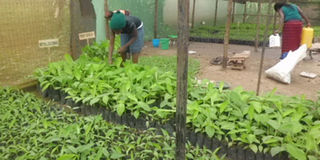EXPERT TAKE: History of plant breeding

Workers tend to banana plantlets at a private owned tissue culture laboratory. PHOTO BY LOMINDA AFEDRARU
For thousands of years, farmers, herdsmen and poultry keepers have been selectively breeding their plants, animals and poultry to improve desirable traits, develop specific characteristics or maintain certain genes.
It was somehow a trial and error process since the actual mechanisms governing inheritance were unknown and knowledge of these genetic mechanisms finally came as a result of careful laboratory breeding experiments carried out over the last two centuries.
By the 1890s, the invention of better microscopes allowed biologists to discover the basic facts of cell division and sexual reproduction.
The focus of genetics research then shifted to understanding what really happens in the transmission of hereditary traits from parents to their offspring.
Particular patterns
A number of hypotheses were suggested to explain heredity, but Fr Gregor Johann Mendel, a monk, who was an Austrian by nationality but born in Germany, was the only one who got it more or less right.
He became known as the founder of the new science of genetics, where he demonstrated that the inheritance of certain traits in cowpeas follow particular patterns. This is now referred to as the laws of Mendelian inheritance.
He discovered that certain properties, which he called particles, existed in the cowpea. His ideas had been published in 1866 but largely went unrecognised until the 1900s, which was long after his death.
Fr Mendel spent his life doing basic genetics research and teaching mathematics, physics and Greek in Brno, now in what is known as Czech Republic.
The profound significance of Mendel’s work where he carried out some cross-pollination was not recognised until the 20th century, when the independent rediscovery of these laws initiated the modern science of genetics.




